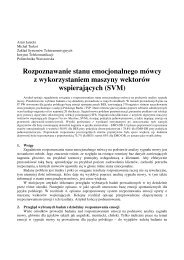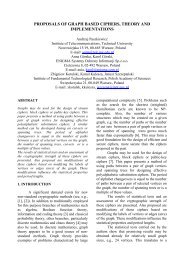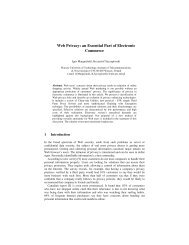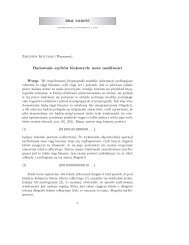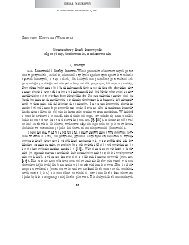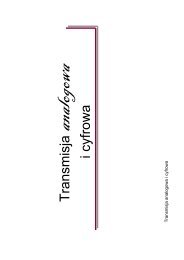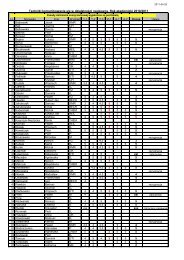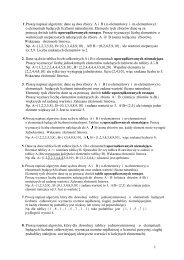supporting different classes of service in ethernet switches with ...
supporting different classes of service in ethernet switches with ...
supporting different classes of service in ethernet switches with ...
You also want an ePaper? Increase the reach of your titles
YUMPU automatically turns print PDFs into web optimized ePapers that Google loves.
4.2.2 RESULTS WITH IMPROVED THRESHOLD TUNING<br />
The simulation studies performed for Ethernet access network showed that controll<strong>in</strong>g shared<br />
buffer occupancy due to STD CoS traffic by means <strong>of</strong> WRED mechanism is not a trivial task. S<strong>in</strong>ce<br />
the control <strong>of</strong> the occupied buffer space is crucial to provide separation between CoSs and <strong>in</strong> this<br />
way, to assure target values <strong>of</strong> QoS parameters, we must precisely control it. It means that only<br />
when STD CoS traffic is TCP controlled, we can assume that the queue size <strong>of</strong> STD CoS is well<br />
limited to the WRED threshold. In the case when this traffic is UDP we cannot assume that the STD<br />
CoS queue size is around desired WRED threshold s<strong>in</strong>ce the simulations proved it is much above it.<br />
For this case, we need to control the queue size more precisely e.g. by sett<strong>in</strong>g lower value <strong>of</strong> WRED<br />
threshold to start dropp<strong>in</strong>g packets earlier. The question aris<strong>in</strong>g is the top value <strong>of</strong> WRED threshold<br />
<strong>in</strong> order not to exceed the target maximum queue size. The answer comes from the analysis <strong>of</strong> the<br />
phenomena, which is responsible for the excessively grow<strong>in</strong>g queue.<br />
S/N<br />
N<br />
CBR traffic<br />
dropp<strong>in</strong>g<br />
WRED<br />
k<br />
Poisson traffic<br />
Fig. 4 Characteristics <strong>of</strong> the arriv<strong>in</strong>g packet stream after pass<strong>in</strong>g WRED mechanism<br />
S<strong>in</strong>ce <strong>in</strong> the considered case, the capacity C 3 is 10 times higher than capacity C 1 and the STD<br />
CoS traffic is assumed to be CBR <strong>with</strong> rate equal to C 3 (see fig. 3), then, dur<strong>in</strong>g the <strong>service</strong> time <strong>of</strong><br />
each STD CoS packet on the l<strong>in</strong>k C 1 , other 10 packets <strong>of</strong> STD CoS arrive to the output port #28.<br />
When the queue size <strong>of</strong> STD CoS packets gathered on port #28 exceeds the WRED threshold (here<br />
85 packets), the WRED mechanism starts dropp<strong>in</strong>g the arriv<strong>in</strong>g STD CoS packets. However, it<br />
drops each <strong>of</strong> them <strong>with</strong> a probability 0.92. On average the rate <strong>of</strong> STD CoS traffic, which passes<br />
through the WRED is only 8 Mbps (i.e. 8% <strong>of</strong> <strong>in</strong>com<strong>in</strong>g traffic) which guarantees that the system is<br />
stable s<strong>in</strong>ce the total rate <strong>of</strong>fered to the output port #28 equals 9.428 Mbps (8 Mbps due to STD<br />
CoS traffic and ρmax×C 28,6 =0.714×2Mbps=1.428 Mbps due to Telephony CoS traffic) and stays<br />
below the <strong>service</strong> rate C 1 (10 Mbps). However, because <strong>of</strong> the probabilistic nature <strong>of</strong> WRED packet<br />
dropp<strong>in</strong>g, it might happen that for some period <strong>of</strong> time more packets than the foreseen average will<br />
pass through the WRED. These packets will contribute to the extensive growth <strong>of</strong> the queue beyond<br />
the WRED threshold. In order to understand how this queue grows it is necessary to characterize the<br />
stream <strong>of</strong> packets that have passed WRED. The fig. 4 illustrates the dependencies between the<br />
packet <strong>service</strong> time S on the l<strong>in</strong>k C 1 , the orig<strong>in</strong>al CBR packet stream (N=10 new packets dur<strong>in</strong>g the<br />
<strong>service</strong> time S) and the stream <strong>of</strong> packets that have passed WRED (k packets out <strong>of</strong> any N arriv<strong>in</strong>g).<br />
S<strong>in</strong>ce consecutive packets are dropped by WRED <strong>in</strong>dependently, the probability distribution <strong>of</strong><br />
the number <strong>of</strong> packets that are not dropped (k out <strong>of</strong> N) is b<strong>in</strong>omial:<br />
⎟⎠⎞<br />
=⎜⎝⎛<br />
S<br />
Pr ob{<br />
k}<br />
N<br />
k<br />
k<br />
p (1 − p)<br />
( N −k)<br />
,<br />
where k = 0,1,..., N and N = 10<br />
(4)




